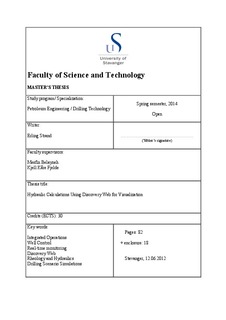| dc.description.abstract | Advanced real-time monitoring systems are useful tools for safe and cost effective well operation practices. As one moves into deeper water, higher pressure and higher temperature, the drilling operations only becomes more challenging. Since the operational drilling window is getting narrower, implementation of good IO technology (i.e. real-time data, technology and people) are necessary to increase safe operations, increase productivity, enhance HSE and reduce NPT. This thesis is divided into a theoretical and a simulation part. The theoretical part presents major downhole drilling problems related to hydraulics, prevention and remedial actions. The theoretical part emphasizes on describing different rheological models for hydraulic calculations. The simulation part presents the real-time monitoring system Discovery Web application developed by Kongsberg Oil & Gas Technologies. In the simulation part, the rheology models are used for hydraulic calculation in different drilling scenarios. Pressure at different locations in the well (Pump pressure (bar), BHP (bar) and ECD (sg)) has been calculated. Different events and unwanted situations are considered and different visualization views have been provided to demonstrate how different well parameters will develop. The input parameters to the models have typically been ROP, flow rate, rheology data and mud density. In order to illustrate the applicability of the implemented models, a case study is presented while drilling a vertical well from 4000m. The following drilling scenarios have been simulated and the results are briefly discussed. These are: Connection scenario, Kick scenario during drilling, Kick scenario during connection, Pack-off scenario and sensitivity of pack-off, Lost circulation scenario, ROP vs cutting concentration scenario, Hydraulics and rheology model comparison scenario and Washout scenario. By building a monitoring panel in Discovery Web, based on the proper rheological models and hydraulic calculations, this thesis have been used to show how models and simulations can be combined in Discovery Web. The experience has been that it was easy to implement the model using Discovery Web Formulas. Another strength of the software is that it is very easy to visualize and import data from real wells in this application. Hence, it is a very good tool for comparing models with real data. This real-time data handling capability and visualization flexibility is considered as one of the major strengths. It has also been shown how to embed events into the models, which later can be used as a basis for developing training scenarios and demonstrations in teaching. The results show how the models implemented can be the first step in introducing models in combination with real-time data for monitoring and handling drilling problems using this application. | nb_NO |

